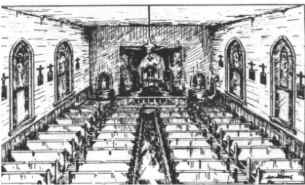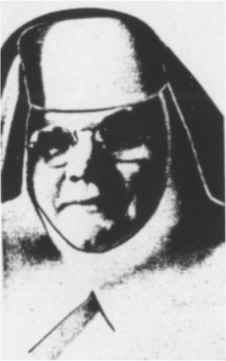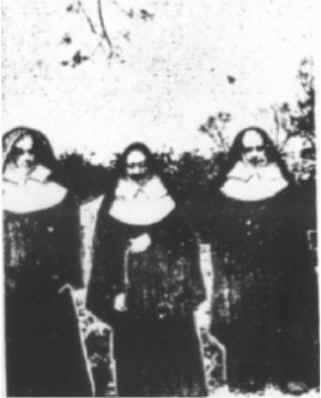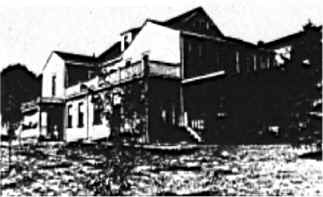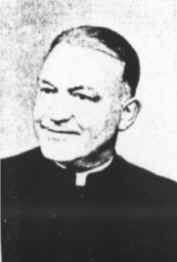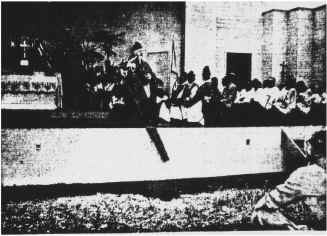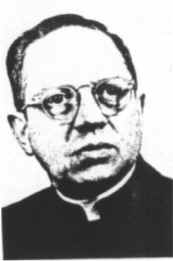|
Mercer County PAGenWeb |
| Greenville | ||||||||||||
|
St. Michaels Church |
||||||||||||
Other missionaries sent out by Bishop
Francis Patrick Kenrick from Philadelphia cared for the
spiritual needs of the little Catholic group in Greenville and environs
intermittently for the next few years. We know, for instance, that in
the summer of 1842 Father Hugh P.
Gallagher of Loretta, Cambria Co., following the path of
the canal, stopped in Greenville and celebrated Mass in the same
McNally home. Present at this Mass in addition to
those mentioned above were: Mark
and Bridget Doyle, Patrick and Anna Doyle, and James Doyle; Richard, John and Patrick Marley
of Greene Township, John Savage
and Mrs. Schoonmaker.
All of these were natives of Ireland with the exception of Mrs. Schoonmaker. Father Gallagher
returned to Greenville at intervals for over a year and was succeeded
by Father
John Reid of the Pittsburgh diocese who took care of the
Greenville Catholics for some years following. During Father Reid’s time a number of
families were added to the congregation. Among them were: Michael Mitchell and family
from Ireland; Michael and Matthias
Schumacher and their wives, Bernard
George and his father, Nicholas
Romelfanger and family, Leonard
Sauers, Christopher Frum and Theodore
Kirk. All of these except the Mitchells
had come from Germany. It was in August of 1842 that
Greenville was favored with a visit from Bishop
Kenrick of Philadelphia. Coming from Mercer and on his way
to Meadville and Erie, he stopped off in Greenville overnight (August
4th-5th) and celebrated Mass in
the morning in the home of Mrs.
Schoonmaker who was a Catholic and whose husband is
recorded as being “well disposed toward the Faith”. At this time three
persons received Holy Communion and five were
baptized. It is worthy of note that one of the latter was the wife of Mr. Bryan McNally who at this
time is described as a woman “advanced in years”. Thus was rewarded the
kindness that provided an altar and chapel for the King of Kings on His
first visit to Greenville. Again
in 1846 Greenville was visited by a member of the hierarchy, this time
by Bishop Michael O’Connor
of Pittsburgh. About his visit here he wrote in his Diary for August
21, 1846: “Travelled through Sharon to Greenville. Greenville is a
rising town said to contain 1500 inhabitants. Being on the canal, much
business is done here. Rev. M.
Mitchell said Mass here in a school house. Confirmed one.
About one hundred Catholics reside in the district. They promise to
take immediate steps to have a church erected here.” FIRST CHURCH The above-mentioned promise to
erect a church was fulfilled two years later in 1848. Signs of
religious bigotry manifested themselves among the various property
owners as soon as it became known that
Father Reid was looking for a site for a Catholic Church.
A little strategy solved the problem. Two parishioners, John and Ferdinand Schmidt (the
latter, a grandfather of Fred Smith,
a present-day [1950] parishioner) who were then laborers at the blast
furnaces, came to Father Reid’s
rescue. They purchased the necessary lots ostensibly for their Ferdinand Schmitt, who together with his brother John, purchased the land for the original church, and deeded it to St. Michael's congregation.
The
original church, a narrow frame structure, was sufficiently
enclosed
for Mass to be celebrated therein before the end of 1848 and in 1849 it
was dedicated as St. Michael’s Church. The interior was lighted with
oil lamps, had the customary three altars and two sacristies, a
baptismal font and stove near St. Joseph’s altar and in the rear a
confessional and stove. There were three windows on either side, oblong
in shape, part colored and part frosted glass. It had both a center and
two side aisles and
seated about 275 people in
its pews which ran four to the width of the church, each pew seating
four persons. Interior of the original church On the occasion of his second visit to Greenville made on August 3, 1851, Bishop O’Connor mentions in his notes that “39 were confirmed and a new frame church has been built but not finished. It is visited once a month by an English priest and once a month by a German priest.” The mention of the non-completion of the Church probably refers to the interior, for an old parish record makes reference to a collection that was taken up between September-November, 1854, for the plastering of the church.With the growth of Greenville, St. Michael’s congregation grew also, and in 1869 an annex was added to the church as well as a gallery, belfry and bell. The bell was solemnly blessed by Bishop Tobias Mullen, on September 4th, 1869, the 16th Sunday after Pentecost, and named after St. John the Baptist. Because Mr. John Savage had made the largest single contribution ($45.00) toward its purchase, Father Tracy accorded him the privilege of naming it. Very human-like, he chose his own patron, St. John the Baptist. By
1889 the need of a larger and more permanent structure for a church was
recognized and Father Bernard
Donohoe, pastor at that time, broke ground for the present
church on October 15th, 1889. The cornerstone was laid in 1890. Almost
four years elapsed before it was completed, at a cost of $35,000.
Apparently the workmanship and materials used were the very best, for
it has well stood the test of time. It must have been more than
adequate for the congregation of that day and, though it isn’t so large
as might be desired to day, it still deserves the title of one of the
most beautiful churches of our diocese. Completed in 1893, St.
Michael’s Church was solemnly dedicated by Bishop The streets of Greenville were crowded with spectators during the passage of the procession. The weather being delightful, many adherents of other churches came to witness the imposing ceremonies. Inside of the new church
The new building was designed by D. K. Dean & Son, of Erie. The structure is 106 feet long and 50 feet wide, has a basement 10 feet deep and is heated by the Smead system. The masonry was done by Andrew Dambacher, contractor, the brick work by Peter McGrath, the carpenter work by Weaver, of Sharon. The Catholics of Greenville have reason to be proud of the church edifice which they have dedicated to the worship of their faith.” SAINT MICHAEL’S SCHOOL
Year, fifty-one years after the opening of our school, we again have Sister M. Ursula with us.
Because the school was opened at the mid-semester the enrollment was
small the first half year (about two students to a grade), but in the
fall of the same year the two class rooms were filled to capacity. Its
first graduation class ceremonies for the two-year course were held in
1906, and for the full high-school course in 1910. Sister M. Ursula, only living [1950] Sister of the three original Sisters of St. Michaels Besides
the nuns already mentioned, other Sisters of Mercy who pioneered in
Catholic education in Greenville were: Mother
M. Austin, Sister M. Nolasca, Sister M. Clare, Sister M. Antonia,
Sister M. Sebastian, Sister M. Mercedes, Sister M. Pierre, Sister M.
Regis, Sister M. Philippa, Sister M. Eugenia, and Sister M. Bernard. The above
names and many more, too numerous to mention will, we are sure, call
back many fond memories for the members of St. Michael’s Alumni.
Catholic education has always rested on the sure foundation of the
utterly devoted, consecrated and sacrificial lives of our teaching
Sisterhoods. Certainly the Sisters of Mercy by the quiet, self-effacing
inspiration of their lives, and the self-sacrificing devotedness
of their labors in Greenville have proved that they have no
peers. In this Centennial we wish to thank them for their loyalty and
devotion. Living or dead we commend them to God.
Three Pioneer Sisters of St. Michael's, Jan 1909. Left to right, Sister M. Ursula, Sister M. Theresa, Sister M. Alexius. 1905 included the following: Mrs. Tillie Sullivan Schwab, Mrs. Laura Hoffman Michaels, Grace Hawkins, Mrs. Margaret Walsh Crowley.Graduates of the two-year high school course in 1906 were: Sister M. Fabiola (Cherubina Christopher), Mrs. Mary Doran Denslinger, Mrs. Katherine Doran Williams, Clara Hoffman, Mrs. Nora Bresnan Henderson, Mrs. Mary Robinson Barrett, Sister M. Antoinette, (Mary Walsh.) Graduates of the first full four-year course in 1910 were: Mrs. Marie Fitzmartin Husted, Sister Mary John (Minnie Brown), Mary Kane, Mrs. Julia Landers Dobrindt, Helen Kane, Theresa Doran, Mrs. Marie Stanton Adams, Mrs. Marion Schumacker Ehrlich, Mrs. Katherine Jaxtheimer Reagle, and Richard Phelan.In 1911 and 1912 the school had no candidates for commencement, but from 1913 to the present, Saint Michael’s has annually presented to the community of Greenville at least a few Catholic High School graduates. The smallest class was that of 1913 with only two graduates: Mrs. Dorothy Brown Wittenauer and Mrs. Alice Robinson Collins; the largest that of 1950 with thirty-one. Large or small, each class received at the hand of the devoted Sisters of Mercy a fine secular education, plus the Christian philosophy and doctrine so necessary to the creation of personalities of real moral worth. To Father John Kearns and to St. Michael’s parishioners is owed a huge debt of gratitude for the spiritual awareness that prompted them to shoulder the burden of building and maintaining a complete Catholic educational system in Greenville. The same spiritual awareness has been kept alive by Father James Kearns down to the present time. That our parishioners of today have caught the proper spirit too, is evidenced by the large-scale improvements made in the school even within the last year. And so, Catholic Education moves on in Greenville, ever true to its purpose—to restore all things in Christ through the lives of its students. At the present time St. Michael’s High School provides four complete courses: Classical, Scientific, Commercial, and General. In addition, true to the old ideal of a “sound mind in a healthy body”, it affords its student body full opportunity for bodily development with its Physical Education program. The latter includes a full annual schedule of football and basketball competition. In accordance with the growth and progress of our school, Mr. Walter Malys, a graduate of Youngstown College was hired in the fall of 1948 as a full-time teacher, and coach of football and basketball. The teams of the “Irish”, as they are locally known, have always been truly representative, making up in spirit what they lack in numbers. Recent evidence of this was furnished last winter when our basketball team was runner-up for the Championship of the Erie Diocese, and when Raymond Giardina, a star of Saint Michael’s, was voted the outstanding player of the entire tournament. Rectory, Convent and Cemetery 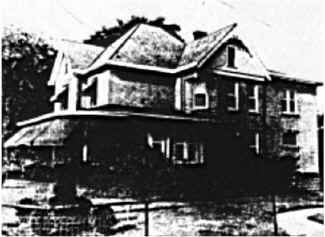
St. Michael's Rectory - 1950 (Click image to enlarge)
This was moved a little farther north and the Sisters occupied it for several months as a temporary convent. When the new rectory was completed, the old parish house was remodeled to provide a very comfortable convent for the Sisters. The temporary convent was sold to William Doran who moved it to its present location at 101 North Second Street. An addition has since been built making it a full two-story home. It is now owned by a parishioner, Gerard Murrin. To the old rectory and first permanent convent an extension was added in 1919-1920. Extensive repairs were also made at that time, and the entire structure was veneered with dark-stained shingles. This also in time became too small as the enrollment of the school increased; and additional teaching Sisters came to care for the pupils. Thus in the summer of 1945 plans were drawn up for a complete remodeling of the convent. A one-story addition, nine feet wide, was added to each side to broaden the building, and at the rear a three-story addition sixteen feet deep was built.
St Michael's Convent - 1950 (Click image to enlarge) The plans, originally drawn by Father James Kearns and approved by the architect, Mr. Edgar E. Clepper of Sharon, were so well conceived and executed that one can hardly discern where the old portions end and the new additions begin. The interior is entirely new and provides a large community room, kitchen, dining room, music room, reception room, sacristy, a beautiful chapel, 19 bedrooms and ample closet and lavatory space. A new gas heating system was installed and modern lighting added throughout. Most of the work was completed in the summer of the following year, and it was ready for occupancy by the time the Sisters returned for the opening of school in September, 1946. The finishing touches, including a complete refurnishing of all the rooms, continued into the late fall, and finally on December 1, 1946 it was thrown open for the approval of the residents of Greenville and environs, Catholic and non-Catholic alike. At least one thousand people visited the convent on this occasion and all were high in praise of its beauty of construction and furnishings.No
history of a parish would be complete without mention of that “God’s
Acre” where rest our dear dead. To them is due a big debt of gratitude
for the fine religious opportunities we now enjoy. It was their labors
and sacrifices that made possible so much of what we now
possess. So
very little is known of the priests who first cared for the spiritual
welfare of Saint Michael’s congregation that we cannot do much more
than list their names and the dates of their administrations. The
baptismal and marriage records of the parish go back to August and
September of 1850 respectively. However, it would seem from Bishop Michael O’Connor’s notes
that at this time and perhaps for a few years thereafter, Greenville
was cared for twice a month by priests from the Pittsburgh area. The
first to sign him self as pastor in the parochial registers is Father Andrew Schweiger, who records
himself as “pastor of West Greenville (as it was then known) and
Sharon. The date is March, 1858. If he was indeed the first pastor, or
if some of the priests who preceded him actually resided here, the
location of their residence is unknown. Perhaps they lived with some
parishioner, or they might even have used part of the church as a
rectory. From other histories of this period the latter seems to have
been not uncommon.
Following
is the list of priests who served
St. Michael’s congregation from its earliest years: Fathers Hugh P. Gallagher (1842-1843) John Reid and M. J. Mitchell (1844-1850),
M. J. Mitchell (1850-1851),
T. A. Smith (1851-1853),
Peter M. Garvey
(1854-1854), Arthur McConnell
(1854-1856), J. Reiser (1856-1856),
Arthur McConnell
(1857-1857), J. J. Gallagher
(1857-1857), Andrew Schweiger
(1858-1859), Joseph Gobbels
(1859-1861), F. J. Hartmann
(1861-1864), John J. O’Keefe
(1864-1866), Kiearan O’Branigan (1866-1868), Thomas Tracy (1868-1876), Bernard Donohoe (1876-1897), P. Cosgrove (1897-1898), J. Lenahen (1898-1898), Rt. Rev. John P. Kearns
(1898-1936), Fathers John Willis
(Assistant—1906-1907), James J.
Kearns (Assistant—1908-1936), James J. Kearns
(Pastor—1936- ), Charles J. Hacherl (Assistant—19361937)
John C. Cronin
(Assistant—1938-1944;
1946- ) and
Francis J.
Johnston (Assistant—1943- ). Besides these, the names of Fathers C. M. Sheehan—1854, Rock—1856, Skopez—1857, Injohn—1865, occur a few odd
times in the old parish records.
Father Francis J. Johnson Assistant 1943 - Inasmuch as Father Thomas Tracy, Father Bernard Donohoe, Monsignor John Kearns and Father James Kearns have served St. Michael’s for the longest periods of time, it seems only proper to cover the periods of their pastorate more completely.
Father Bernard Donohoe, the son of James and Brigid (Keirnan) Donohoe, was born in Ardlenny, County Cavan, Ireland, on August 15, 1852. He attended the national schools till the age of twelve and then was sent to a classical academy, located on the banks of the celebrated Lough Sheelan, in his native county. There he spent six years acquiring a knowledge of the humanities. In August, 1870, he left Ireland, came to New York City, and soon afterward entered St. Bonaventure’s College, Allegany, New York. After completing his theological studies there he was ordained for the Erie Diocese by Bishop Tobias Mullen, June 7, 1875 in the Erie Cathedral. His first appointment was as an assistant priest at St. Thomas’ Church, Corry, Pa. In December, 1874, he was given charge of Lepanto, Clarion County. Early in 1875 he moved again, this time to St. Michael’s Church, Emlenton, Venango County. He was there but a short time when he was sent as pastor to Immaculate Conception Parish in Rome, Crawford County. His stay in Rome was short too, for he returned to Corry as pastor in the Fall of 1875. He remained in Corry until 1876 when he was appointed pastor of St. Michael’s Church, Greenville. During
his long pastorate of twenty-one years in Greenville, Father Donohoe witnessed a
large increase in the size of the parish that added to his many labors.
Moreover, in the years when Jamestown was not an independent parish, he
attended St. Bridget’s congregation as a mission, celebrating Mass
there once a month. It is also known that regularly for years he
offered Mass on week days for a group of Catholic miners in Orangeville. which
our rectory lies as well as a four acre tract as an extension to St.
Michael’s cemetery. In addition, he finished the interior of St.
Brigit’s church, Jamestown, and paid off a considerable debt still due
on that building when Father Tracy left. Of his work in Greenville, the
Mercer County History of 1888 records that “he has done a great deal
toward building up St. Michael’s congregation, which is today in a more
flourishing condition than during any period of its history.” The same
account mentions that in 1888 St. Michael’s parish had over five
hundred souls and a Sunday school of one hundred pupils. Comparatively
speaking, those were still pioneer days in the Erie diocese, days of
the horse and buggy, days wanting in the many conveniences, comforts
and facilities we now enjoy. Accordingly it is difficult for us of
today to appreciate fully the labors of the priesthood of those earlier
years. There are, of course, still a fair number of present-day
parishioners who remember Father
Donohoe well. All agree that he was a zealous, kind,
devoted pastor. At
the death of Monsignor Kearns
the following sincere and spontaneous tribute was paid to him by his
life-long friends and educational associates, the Sisters of Mercy. We
quote it as it appeared in local and diocesan papers, under date of
March 13, 1936. “Last
week local papers carried the sad details of the death and funeral
rites of one of the most distinguished prelates of the Erie diocese,
the Rt. Rev. Msgr. John P. Kearns,
pastor of St. Michael’s Church, Greenville, Penna. Here
indeed was a man upon whose life we may reflect, with profit to
ourselves: a gentleman of the “old school”; a scholar in the best sense
of that much-abused word; a philosopher, unspoiled by the pseudo-trends
of our modern age; an idealist who preserved his idealism amidst the
crass realism of our times, and throughout the long span of 70 years; a
man with a vision constantly ranging beyond time, into the beautiful
distances of Eternity—a priest of God whose highest boast was his
priesthood, and his unswerving devotion to his flock. How
easy it should be to write of such a man, and yet how difficult. One
cannot measure spiritual values on the scales of time, nor span years
of zealous priestly service with a bridge of mere words. Those who knew
“Father John” intimately, remember him as a pioneer priest who went to
Greenville al moat forty years ago. A tall, silent man with the
consecrating oils still fresh upon his hands, and the fires of
spiritual conquest burning in his eyes. In the kind, open countenance,
welcoming smile and slightly stooping figure, one might easily
recognize the true pastor. But Greenville, throughout these four decades, knew Monsignor John learns as more than educator and pastor. In the eyes of that community he was universally regarded as its first
citizen. His was a familiar figure on the Greenville streets, in the
homes of the sick, in civic and recreational centers, and wherever life
was lived cleanly and vigorously. Frequently he stimulated the cultural
and artistic life of Greenville, contributing perhaps more than any
other one person to its general betterment. The many friends who
thronged St. Michael’s Church while his body lay in state there, gave
ample proof of the esteem in which Monsignor
Kearns was held. Someone
has said that we may count the virtues of the departed by the tears
shed over them by the poor. As one approached the sanctuary of St.
Michael’s Church to view the holy remains of its pastor, one had the
opportunity to observe those who wept. There were the tears of hundreds
of little children, who had somehow lost their guardian, their kind and
gentle friend, their priestly idol; there were the tears of nuns, who
for many years had been heartened and encouraged in their works of
charity by this saintly, spiritual guide; there were the tears of men
and women, weighed down with the burdensof
life, mourning the loss of a counselor and advisor; there were the
slow, bitter tears of the aged, who were to miss in their last hours
the consolation of this true friend and devoted pastor. From all there
were tears of gratitude. “Father
John” was buried on the brow of a hill overlooking his departed flock,
in the consecrated spot known as St. Michael’s cemetery, where repose
the remains of hundreds over whom he had himself pronounced the
“Requiescat.” There was something peculiarly significant in the fact
that he was laid to rest on a bright spring day, with the taste of
early spring in the air, with nature itself giving promise of renewed
life. For “Father John” was above all else, a firm believer in the
“Eternal Springtime.” He had a simple abiding faith in the glory of the
life to come, and he communicated that faith and confidence to all with
whom he dealt. Death was to him not a mystery, but a symbol of, a key
to, the complete and more perfect life. “Father
John” shunned worldly honors, preferring to engrave his name on human
hearts rather than on marble. When in 1931, through the recommendation
of his Bishop, the title of Domestic Prelate was conferred on him, he
received the honor quietly, seeming, as his friends said, to dignify
the purple that he wore.” Monsignor Kearns was born in
Hubbard, Ohio, December 5, 1866, the son of the late Michael and Mary Dougherty Kearns,
natives of Ireland. He attended
St. Bonaventure’s College at Allegany, N. Y., and was ordained a priest
May 1, 1897. Father James J. Kearns—Pastor 1936The
chronicle of a century of progress in St. Michael’s Parish, Greenville,
Pennsylvania, would be indeed incomplete without mention of its present
well-beloved Pastor, Reverend James
J. Kearns, who has served the, parish for almost his
entire priestly life of forty-two years. At this time it is the
pleasure of the Centennial Committee to present a modest tribute to one
who has served the spiritual interests of St. Michael’s people loyally
and well. Father James Kearns was born
June 3, 1876 in Elk City, Clarion County, the fifth son of Mary Daugherty and Michael Kearns.
He received his early education in the public schools of that district,
later moving to Reynoldsville. Upon completing high school, Father
James began an intensive study of instrumental music. Endowed with
unusual musical ability and a rich baritone voice, he soon became the
center of choral and choir groups, and a member of the then well-known
Keystone Band. As early as 1900 he was touring Clearfield and Jefferson
Counties, giving concerts, and acting in amateur plays. Those who knew Father James best during his early years of service, recall particularly, his self-sacrificing devotion to his priest-brother, and his great zeal in instructing and directing the young people of St. Michael’s Parish. Long before the so called Youth Movement took root in this country, certainly before the Little Theatre Movement caught the public fancy, Father James pioneered in Catholic theatre, guiding and directing the cultural and social life of the younger members of St. Michael’s Parish. During the past four decades, Father James personally directed 12 major musical shows, many of which were recalled for a second and even third performance in Greenville, New Castle, Sharon, drew his youthful “thespians” from the rank and file of St. Michael’s Grade and High School. To the heavier, adult parts of the large musicals, residents of all sections of Greenville, Catholics and non-Catholics alike, contributed talent. When
no suitable play was to be found among current Broadway productions,
Father James wrote his own plays, adapting them to local conditions and
talent. The most popular among these were Kid Kapers
and Carmelita, written, staged, and directed by the
Greenville priest, and played seven different times before enchanted
audiences. On one of these seven occasions, on April 29, 1935,
KID KAPERS was presented over the National Broadcasting
Company network to the delight of all who heard it. In the hands of Father James, however, the drama was never an end in itself, but rather the means to a far nobler end, namely, the organizing of the youth of the Parish for the purpose of promoting their best spiritual, as well as cultural, and social interests. As a result, many of these young troubadours sang and danced their way into the religious life. Today they are passing on this heritage as teaching Sisters in many Diocesan schools. Others have gone out from the ranks of ST. MICHAEL'S PLAYERS into business, professional, and happy family life, better Christians, better citizens, for this special training. Today it is the privilege of ST. MICHAEL’S PLAYERS everywhere, to pay grateful tribute to their friend and “Director”, Father James. From the vantage point of mature years, they appreciate the genius which caught and held their youthful enthusiasm, directing it, carefully, for service to God, to country, and to their community.In 1936, at the death of Monsignor John Kearns, Father James, after his long tenure as Assistant, was appointed Pastor of St. Michael’s, this at a time when the community and the parish were recovering from the effects of a depression. The new Pastor assumed the parish debt willingly. With the cooperation of his self-sacrificing people, and that of his hard-working Assist ant priests, he began to liquidate the debt, and at the same time, to enlarge and to improve the Church property. Within the past fourteen years, St. Michael’s Grade and High School has been renovated, the Church redecorated twice, and St. Michael’s Cemetery beautified. Undoubtedly
the greatest material contribution made to the Parish by Father James
was the enlarging, renovating, and refurnishing of the local Convent.
Today the Sisters’ home in Greenville is one of the most comfort able
and well-appointed convents in the Diocese. Today, in a spirit of joyful reminiscence, the old and the young pledge renewed loyalty to their devoted Pastor, Father James, and they wish for him many more golden years of service. Gratitude is a noble and delicate virtue; it dwells more surely in the heart than on the lips. In this centennial year St. Michael’s people express their gratitude to God for the blessings of their Holy Faith. They thank all who have served them in His Name. PARISH GROWTH AND COMPOSITION Of interest, too are the various national backgrounds of the people composing a parish. The earliest accounts of the parish history reveal that in those days, German and Irish names were pretty evenly distributed. About 1842-1848, a comparatively heavy increase in the number of natives of Germany is noticed. For a few of these years they almost certainly formed the largest group attending Mass in the home of Mrs. Schoonmaker, Ferdinand Schmidt, or the old public schoolhouse. The famine in Ireland in 1845 which drove so many of her sons and daughters to our shores undoubtedly accounts for the notable increase of Irish names in succeeding years. From 1850 until almost 1900, practically all the names on the parish registers are either Irish or German, with the Irish predominating by a margin of about two to one. In 1894 the first natives of Sunny Italy came to Greenville and registered as parishioners of St. Michael’s. Since “firsts” are always of interest, we should note that the names of our first Italian parishioners were Mr. and Mrs. Albert D. Christopher, the parents of Sister Fabiola of the Sisters of St. Joseph and of Frank Christopher, who made a name for himself in so many of Father James’ theatrical productions. A Greek name, James Caravosios, appears in 1895. Others of Italian origin to join us in later years were: Salvatore Catalano, 1900, who still calls St. Michael’s his parish as do six of his children; Gaetano Daniello, 1905, a member of the parish now and father of four other adult parishioners. Slovak names: Joseph Chvila and Cyril Zahradnik, appear as early as 1901; Polish: George Bolak and Mary Solanski in 1902; French: John Babeaux, father of Sister Mary Francis of the Sisters of Mercy, in 1902; and Mary Jacquett (Mrs. William Junk), in 1903. Dutch: Phillip Van Dusen in 1902, and Anna Van Dusen (Mrs. Harvey Simons) in 1904; Croatian: Louis Caruti and Christina Kowatavitch in 1904; Syrian: Mary Hand in 1908. From about 1907 there was a steady increase of most of the above mentioned nationalities, until today our membership according to families runs somewhat as follows: 190 Irish, 150 German, 130 Slovak, 125 Italian, 60 Croatian, 25 Polish. Besides these, other nationalities represented at the present time are: Hungarian, Russian, Swedish, Rumanian, Syrian, Dutch, Macedonian, French, Bulgarian, Scotch, Serbian and English. In making the above estimate we have taken into account the many cases of intermarriage between young men and women of varying national extractions. In fact, because of intermarriage, it is no longer possible to classify many of our people as being purely of a particular national origin. So well have they mingled, and so little trace of false nationalism is to be found, that our parish is truly an “American Melting Pot” in the best sense of that expression. Though all are proud of their native lands or descent, they are still more proud to be able to call themselves Americans. Motivated by a spirit of Christian charity, they have learned well that they who kneel side by side at the altar rail to receive the Bread of Life are all one body Christ, and that national backgrounds must submerge themselves in that higher unity to be found in the Christ-Life. ST. MICHAEL’S AND THE WAR Saint
Michael’s first association with the armed services of World War II was
in the person of Father Charles J.
Hacherl, who served as an assistant to Father James learns
from June of 1936 to August of 1937. At this time Father Hacherl joined
the United States Navy as a chaplain. He served in that capacity during
peace time, throughout the entire war period, and after the war until
May, 1947. Severing his relationship with the armed services, he
returned to the diocese of Erie in July, 1947 and was appointed pastor
of Saint Nicholas’ Parish, Crates, Pa.
Father Charles J. Hacherl, Assistant 1936 - 1937 The war was brought still closer to our parish when, because of a good water supply and excellent railroad facilities, Greenville was chosen as a site for an army camp. Named Camp Shenango and later Camp Reynolds, the local Army installation was located three miles out of Greenville on the Greenville-Sharon road. Camp Shenango received its first cadre of soldiers in the late fall of 1942. Before Father James Campbell of Pittsburgh arrived, about February, 1943, to take over his duties as the first Catholic Chaplain, Father John Cronin, of Saint Michael’s and Father Robert Goodill of Saint Brigid’s, Meadville, took care of the spiritual needs of the Catholic soldiers on Saturdays and Sundays. About May of 1943, and after Father Campbell had been released for foreign service, Father Francis X. Cronin of the New York diocese, arrived to take over the chaplain’s duties. Father Francis J. Gorham of the Raleigh diocese, who came a month or two later, filled the quota of Catholic chaplains assigned to Camp Shenango.
Field Mass, Camp Reynolds, August 15, 1943 The most important event of these days from a religious viewpoint was the Solemn Field Mass celebrated on the Feast of the Assumption, 1943. The attendance for this ran to several thousand. Bishop John Mark Gannon, who presided at the Mass, also delivered a stirring address on the religious foundations of our Democracy. Father James learns was celebrant of the Mass, while the chaplains, Fathers Cronin and Gorham were deacon and subdeacon respectively.
Father John C. Cronin, Assistant, 1936 - 1944, 1946 - Saint Michael’s lost its second priest to the armed services when in March,1944, Father John C. Cronin enlisted in the Army, a position he filled until his return to St. Michael’s in May, 1946. About July-August, 1944, when both Father F. X. Cronin and Father Gorham received overseas orders, Father Johnston of Saint Michael’s was appointed as an auxiliary chaplain to serve the Catholic soldiers of the local camp. He acted in this capacity until the dismantling of the camp at the end of the war, caring for the spiritual needs first of our American troops, and later of the Prisoners of War sent to Camp Reynolds. Until
it became a camp for Prisoners of War, Camp Shenango and Camp Reynolds
had been used as a Replacement Center which prepared and equipped
American troops for overseas duty. At one time it had a capacity of
thirty thousand men. The length of stay for those preparing for foreign
duty varied from a few days to two or three weeks or even a month.
Because of the nature of the camp, a large number of Catholic
Chaplains, probably between three hundred and three hundred and fifty
were readied here for foreign service. St. Michael’s Rectory became
their second home during those days and Father
James Kearns their very genial host. Gold Stars indicating death in the service of their country appear before the names of: Edward P. Becker, U.S.N.; Andrew Benetin, U.S.A. [U. S. Army]; Joseph Carmont, U.S.A.; Gus Kefurt, U.S.A.; Joseph Koss, U.S.A.C.; William Kelly, U.S.N.; Richard P. Moss, U.S.M.C.; Daniel Nankoff, Jr., U.S.A. May they rest in peace.
|
||||||||||||
Return to Churches Home Page
Return to Mercer County Home Page
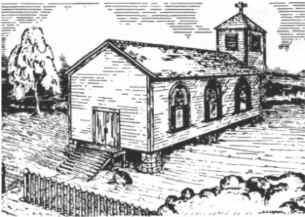

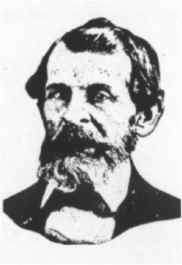 own
own